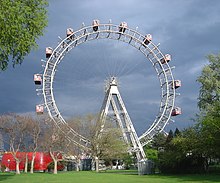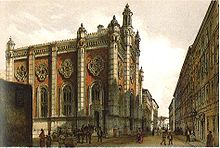
Leopoldstadt or Leopold-Town is Vienna's 2nd district. There are over 95,000 inhabitants and is about 7 sq miles. Leopolstadt and, Brigittenau, the 20th district), form a large island surrounded by the Danube Canal and the Danube River.
 History of Leopoldstadt
History of Leopoldstadt In 1625 Rabbi Yom-Tov Lipmann Heller became the rabbi of Vienna and was instrumental in reorganizing the Jewish community of Vienna and drew up its constitution. Heller obtained for the Jews the rights to establish a central Jewish community in Leopoldstadt, which was a suburb of Vienna at the time. In the mid-17th century, part of the area was used as a Jewish ghetto, called "Im Werd." The Jewish population was called "Unterer Werd."
Leopold I, expelled the Jews and the Jewish community (gesera), with the popular support. The new non-Jewish inhabitants renamed the area Leopoldstadt in thanks. However, Jewish immigrants from eastern parts of the realm tended to immigrate to Leopoldstadt though the centuries. The high number of Jewish inhabitants led to the area being called Mazzesinsel (Island of Mazzes bread). Several important synagogues such as the Schiff Shul, the Leopoldstädter Tempel, Türkischer Tempel, Polnische Schul and Pazmanitentempel and yeshivas were located there.
 The Kristallnacht pogroms of November 1938 following the annexation of Austria by Nazi Germany were so successfully destructive, none of the synagogues survivied. The Jewish population was systematically isolated, terrorized, and finally deported and murdered in the concentration camps. The once thriving communal life was completely destroyed. Only a handful of survivors were able to hide until the end of the war.
The Kristallnacht pogroms of November 1938 following the annexation of Austria by Nazi Germany were so successfully destructive, none of the synagogues survivied. The Jewish population was systematically isolated, terrorized, and finally deported and murdered in the concentration camps. The once thriving communal life was completely destroyed. Only a handful of survivors were able to hide until the end of the war.The fall of the Iron Curtain in 1989 renewed immigration from Eastern Europe, especially from the former Soviet Union, with a new Jewish population. Today, Leopoldstadt is again the center of Vienna’s Jewish community with kosher shops. Lately, the old residential areas are being gentrified. The new extension of the U2 metro line was opened in May 2008.
Sites of Leopoldstadt
The Wiener Prater (from Latin pratum "meadow"), which was the former imperial hunting grounds, takes the majority of the land of the 2nd district and was opened to the public in 1766. The Prater is home to a large amusement park, known as the Volksprater (People's Prater) or Wurstelprater (after the Harlequin-type figure of Hanswurst). The giant Wiener Riesenrad (Ferris wheel) that was opened there in 1897. This Ferris wheel has become a symbol of the city and is features prominently in the movie The Third Man. There is also a miniature steam railway called the Liliputbahn through the wooded park land. The Schweizerhaus (Swiss House) has a huge beer garden and its owners claim that, the potato crisp was invented there in the 1920s. Nearby you can find the Republic of Kugelmugel, a micronation proclaimed in 1984.
Another small park in Leopoldstadt is the Augarten, which is the home of the Vienna Boys' Choir and of a porcelain manufactory, Augarten-Porzellan. Its most distinguishing marks are two disused Flak towers built towards the end of the Second World War.
Other sites:
* Galopprennplatz Freudenau
* Johann Strauss Museum (Vienna Museum)
* Augarten Bridge
* Odeon
* Leopold Church
* "Mexico Church"
* Tegetthoff Monument
* Vienna Crime Museum
* District Museum Leopoldstadt
Other notables:
The Museum für Unterhaltungskunst - the history of clowns, artists and circuses
the Museum des Blindenwesens - the development of teaching the blind and Braille.
The Augarten Contemporary (contemporary art) and the neighboring
Gustinus-Ambrosi Museum.